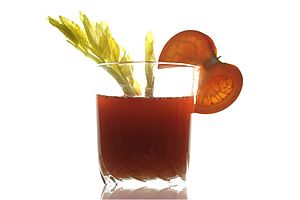Tomato juice facts for kids
| Nutritional value per 100 g (3.5 oz) | |
|---|---|
| Energy | 73 kJ (17 kcal) |
|
3.53 g
|
|
| Sugars | 2.58 g |
| Dietary fiber | 0.4 g |
|
0.29 g
|
|
|
Protein
|
0.85 g
|
| Vitamins | Quantity
%DV†
|
| Vitamin C |
84%
70.1 mg |
| Other constituents | Quantity |
| Water | 94.24 g |
| †Percentages estimated using US recommendations for adults. | |
Tomato juice is a popular juice made from tomatoes. People often drink it plain, or they mix it into special drinks. Some well-known mixed drinks that use tomato juice include the Bloody Mary, the Caesar, and the Michelada.
Contents
How Tomato Juice Started
Tomato juice was first served as a drink way back in 1917. This happened at the French Lick Springs Hotel in Indiana, USA. A man named Louis Perrin was working there. He suddenly ran out of orange juice for his guests.
He needed a quick replacement. So, he squeezed some tomatoes, added sugar, and a special sauce. This new tomato drink was an instant hit! Businessmen from Chicago loved it and told everyone about this new "tomato juice cocktail." Soon, it became very popular.
How Tomato Juice is Made
Many companies that make tomato juice add extra ingredients. They often add salt to make it taste better. Sometimes, they also add onion powder, garlic powder, and other spices for more flavor.
In the United States, companies started selling a lot of tomato juice in the mid-1920s. It quickly became a popular drink to have with breakfast.
Most tomato juice in the United States is made from something called tomato paste. Tomato paste is a thick, concentrated tomato product.
In Canada, tomato juice is made differently. It is not concentrated. It's made from fine tomato pulp from ripe, whole tomatoes. The stems and skins are removed, and no extra water is added to the final juice. Canadian tomato juice might also have a little bit of sweetener, citric acid (which makes it slightly sour), and salt.
What is Tomato Juice Used For?

Tomato juice is used in many ways around the world.
Popular Drinks
In Canada and Mexico, people often mix tomato juice with beer. In Canada, this mix is sometimes called a Calgary Red-Eye. In Mexico, it's known as Cerveza preparada.
Tomato juice is also the main ingredient for famous mixed drinks like the Bloody Mary and the Bloody Caesar. Another popular mixer that uses tomato juice is Clamato. In the UK, people often combine tomato juice with Worcestershire sauce for a tasty drink.
Other Uses
Chilled tomato juice used to be a popular starter drink at restaurants in the United States. It was often served before the main meal.
Tomato juice is also used when canned tomatoes are packaged. It helps keep the tomatoes fresh inside the can. Sometimes, a thicker tomato purée is used instead, especially for international trade. However, many people think tomatoes packed in juice taste fresher.
Scientists also use tomato juice to grow certain types of tiny living things called Lactobacillus. They use a special jelly called tomato juice agar for this.
Why People Drink it on Airplanes
Tomato juice is a very popular drink for people flying on airplanes. One idea is that the loud noise and air pressure inside an airplane cabin change how we taste things. Some studies suggest that the "umami" flavor (a savory taste) in tomato juice becomes stronger and more enjoyable when you're flying. Another idea is that it has simply become a tradition, like eating popcorn at the movies.
See also
 In Spanish: Jugo de tomate para niños
In Spanish: Jugo de tomate para niños


